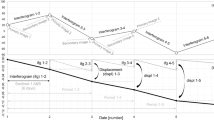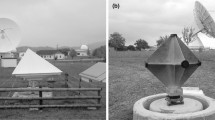Abstract
At present, the satellite SAR persistent scatterer interferometry can already estimate surface changes with a near to 1 mm theoretical precision limit. However, the ascending and descending acquisitions of available SAR services cannot provide three-dimensional changes routinely, though the slow deformation processes are basically three-dimensional (3D). In this paper the geometric features of ascending and descending SAR data and possible fusion with geodetic data are summarised. All the geometric equations are introduced, which are necessary to derive the two characteristic changes in the observation plain defined by ascending and descending unit vectors pointing to SAR satellite positions. The unambiguously derivable characteristic changes can be transformed into vertical and east changes, but they may be biased by possible north displacement. The geometric features of symmetric and asymmetric acquisitions are also investigated. Monte-Carlo simulation is used to investigate the precision of two estimated components. It is experienced that the precisions are not sensitive to one degree standard deviations of positional angles. The Gauss–Markov model of least square adjustment method is used to derive only the statistical properties of reasonable data fusion which can contribute to the 3D applications. Although complementary satellites, which are already proposed in the literature, could provide precise autonomous solutions, in the practise GNSS and levelling data can be used for direct data fusion. Whereas, even errorless levelled high changes cannot contribute to the proper estimation of northern components, GNSS derived changes are the best candidates, which can be interpolated or measured directly. Moreover, these two techniques can properly compensate the weaknesses of each other. The interferometric SAR techniques are not sensitive enough to the north changes, but can contribute to the precision of height estimation, which are the weakest components of the GNSS technique. This statement is valid if the standard deviations of combined data are comparable. For test computations the geometric parameters of available Sentinel-1A images are used, which cover the area of the Széchenyi István Geophysical Observatory, where experimental integrated geodetic benchmark is located combining ascending and descending backscatterers with the possibility of the GNSS, gravimetric and traditional geodetic measurements, as well.




Similar content being viewed by others
References
Bányai L, Mentes Gy, Újvári G, Kovács M, Czap Z, Gribovszki K, Papp G (2014) Recurrent landsliding of a high bank at Dunaszekcső, Hungary: geodetic deformation monitoring and finite element modeling”. Geomorphology 210:1–13
Cascini L, Fornaro G, Peduto D (2010) Advanced low- and full-resolution DInSAR map generation for slow-moving landslide analysis at different scales. Eng Geol 112:29–42
Catalao J, Nico G, Hanssen R, Catita C (2011) Merging GPS and atmospherically corrected InSAR data to map 3-D terrain displacement velocity. IEEE Trans Geosci Remote Sens 49(6):2354–2360
Colesanti C, Ferretti A, Prati C, Rocca F (2003) Monitoring landslides and tectonic motions with the permanent scatterers technique. Eng Geol 68:3–14
Garthwaite, M.C., Thankappan, M., Williams, M.L., Nancarrow, S.; Hislop, A., Dawson, J. 2013. Corner reflectors for the Australian Geophysical Observing System and support for calibration of satellite-borne synthetic aperture radars. IGARSS 2013 publication, pp 266–269
Gisinger C, Balss U, Pail R, Zhu XX, Montazeri S, Gernhardt S, Eineder M (2015) Precise three-dimensional stereo localization of corner reflectors and persistent scatterers with TerraSAR-X”. IEEE Trans Geosci Remote Sens 53(4):1782–1802
Gray L (2011) Using multiple RADARSAT InSAR pairs to estimate a full three-dimensional solution for glacial ice movement. Geophys Res Lett 38:L05502. doi:10.1029/2010GL046484
Gudmundsson S, Gudmundsson MT, Björnsson H, Sigmundsson F, Rott H, Carstensen JM (2002) Three-dimensional glacier surface motion maps at the Gjalp eruption site, Iceland, inferred from combining InSAR and other ice-displacement data. Ann Glaciol 34(1):315–322
Guglielmino F, Nunnari G, Puglisi G, Spata A (2011) Simultaneous and integrated strain tensor estimation from geodetic and satellite deformation measurements to obtain three-dimensional displacement maps. IEEE Trans Geosci Remote Sens 49(6):1815–1826
Hooper A (2008) A multi-temporal InSAR method incorporating both persistent scatterer and small baseline approaches. Geophys Res Lett 35(16):1–5
Hooper A, Zebker H, Segall P, Kampes B (2004) A new method for measuring deformation on volcanoes and other natural terrains using InSAR persistent scatterers. Geophys Res Lett 31:L23611
Hooper A, Bekaert D, Spaans K, Arikan M (2012) Recent advances in SAR interferometry time series analysis for measuring crustal deformation. Tectonophysics 514–517:1–13
Hu J, Li ZW, Ding XL, Zhu JJ, Zhang L, Sun Q (2014) Resolving Three-dimensional surface displacements from InSAR measurements: a review. Earth Sci Rev 133:1–17
Hung WC, Hwang C, Chen YA, Chang CP, Yen JY, Hooper A, Yang CY (2011) Surface deformation from persistent scatters SAR interferometry and fusion with leveling data: a case study over the Choushui River Alluvial Fan. Taiwan. Remote Sensing of Environment 115(4):957–967
Kumar V, Venkataramana G, Høgda KA (2011) Glacier surface velocity estimation using SAR interferometry technique applying ascending and descending passes in Himalayas. Int J Appl Earth Obs Geoinf 13(4):545–551
Manzo M, Ricciardi GP, Casu F, Ventura G, Zeni G, Borgström S, Berardino P, Del Gaudio C, Lanari R (2006) Surface deformation analysis in the Ischia Island (Italy) based on spaceborne radar interferometry. J Vulcanol Geotherm Res 151(4):399–416
Meyer FJ, McAlpin DB, Gong W, Ajadi O, Arko S, Webley PW, Dehn J (2015) Integrating SAR and derived products into operational volcano monitoring and decision support systems. ISPRS J Photogramm Remote Sens 100:106–117
Plank S, Singer J, Thuro K (2013) Assessment of number and distribution of persistent scatterers prior to radar acquisition using open access land cover and topographical data. ISPRS J Photogramm Remote Sens 85:132–147
Riddick SN, Schmidt DA, Deligne NI (2012) An analysis of terrain properties and the location of surface scatterers from persistent scatterer interferometry. ISPRS J Photogramm Remote Sens 73:50–57
Rocca F (2003) 3D motion recovery from multi-angle and/or left right interferometry. In: Proceedings of the third international workshop on ERS SAR
Samsonov S, Tiampo K (2006) Analytical optimization of a DInSAR and GPS dataset for derivation of three-dimensional surface motion. IEEE Geosci Remote Sens Lett 3(1):107–111
Samsonov S, Tiampo K, Rundle J, Li Z (2007) Application of DInSAR-GPS optimization for derivations of fine-scale surface motion maps of Southern California. IEEE Trans Geosci Remote Sens 45(2):512–521
Tralli DM, Blom RG, Zlotnicki V, Donnellan A, Evans DL (2005) Satellite remote sensing of earthquake, volcano, flood, landslide and coastal inundation hazards. ISPRS J Photogramm Remote Sens 59:185–198
Újvári G, Mentes Gy, Bányai L, Kraft J, Gyimóthy A, Kovács J (2009) Evolution of a bank failure along the River Danube at Dunaszekcső, Hungary. Geomorphology 109:197–209
Wasowski J, Bovenga F (2014) Investigating landslides and unstable slopes with satellite Multi Temporal Interferometry: current issues and future perspectives. Eng Geol 174:103–138
Wright TJ, Parsons BE, Lu Z (2004) Toward mapping surface deformation in three dimensions using InSAR. Geophys Res Lett 31:L01607. doi:10.1029/2003GL018827
Acknowledgments
This study was funded by the Government of Hungary through an ESA Contract (No. 4000114846/15/NL/NDe/15/NL/NDe) under the PECS (Plan for European Cooperating States). The view expressed herein can in no way be taken to reflect the official opinion of the European Space Agency.
Author information
Authors and Affiliations
Corresponding author
Rights and permissions
About this article
Cite this article
Bányai, L., Szűcs, E. & Wesztergom, V. Geometric features of LOS data derived by SAR PSI technologies and the three-dimensional data fusion. Acta Geod Geophys 52, 421–436 (2017). https://doi.org/10.1007/s40328-016-0183-3
Received:
Accepted:
Published:
Issue Date:
DOI: https://doi.org/10.1007/s40328-016-0183-3




